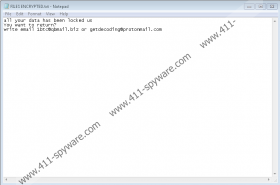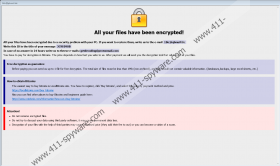Bitx Ransomware Removal Guide
Bitx Ransomware is an infection that displays a warning with a golden lock image and a text. According to this message, all files have been encrypted and cannot be accessed without decrypting them first. The note may also claim that hackers who created this malware have the needed decryption tools and can deliver them if a user does what they ask. As you probably understand, dealing with cybercriminals might be risky and if you do not think it to be wise you, we advise paying no attention to their requests. Another thing that we highly recommend is not to leave this malicious application on your system. Further, we explain why it could be dangerous as well as other things about the malware, including how to remove Bitx Ransomware.
Explaining how this infection could end up on your device would probably be the best way to begin this report. Specialists say that Bitx Ransomware is likely to travel via Spam emails or unsecured RDP (Remote Desktop Protocol) connections. Therefore, if you want to guard your computer against such threats, we advise being careful with files received via email. All files received from questionable sources or unexpectedly, should be scanned with a reliable antimalware tool if you want to open them. Moreover, you should secure your RDP connections. Plus, to ensure there are no other vulnerabilities besides unsecured RDP connections, we recommend changing old and weak passwords as well as updating outdated software.
After a victim gets tricked into opening Bitx Ransomware, the malware should settle in by creating copies of itself in the %WINDIR%\System32, %APPDATA%\Microsoft\Windows\Start Menu\Programs\Startup, %ALLUSERSPROFILE%\Microsoft\Windows\Start Menu\Programs\Startup, and %ALLUSERSPROFILE%\Application Data\Microsoft\Windows\Start Menu\Programs\Startup locations. Also, the threat should create a few Registry Entries that might make an infected computer launch the malicious application and its warning message after each system restart. Once such data gets created, the malware ought to begin the encryption process. During it, Bitx Ransomware should lock various personal files and append the .id-{random characters}.[1btc@qbmail.biz].bitx extension, e.g., receipt.pdf.id-6D9E198C.[1btc@qbmail.biz].bitx.
Next, Bitx Ransomware should display the earlier described warning or a ransom note. Besides the golden lock image, it should contain instructions telling how to contact the threat’s developers via email. Also, it should say that encrypted files can be recovered with decryption tools that hackers have. To prove they have them, cybercriminals may offer decrypting one small file. It is said that it will cost nothing, which meaning decrypting all of your files would require making a payment. We do not know how much money hackers may demand you to pay. However, if you decide not to risk your money no matter how huge or small the ransom could be, we advise you not to contact them. Keep in mind that if you have backup copies, you could use them to replace encrypted files, and so, there might be no need to decrypt your data.
Leaving Bitx Ransomware on your device could be dangerous due to its created Registry entries, which may allow it to restart with system. When the malicious application restarts, it is possible it could look for files it has not encrypted before and lock them. Therefore, to make sure it does not happen, we advise removing Bitx Ransomware with the instructions available below or a reliable antimalware tool if the provided steps seem too challenging. We should also mention that instead of doing the first 5 steps, you could restart your computer in Safe Mode with Networking as it might be easier to do so.
Get rid of Bitx Ransomware
- Press Ctrl+Alt+Delete.
- Choose Task Manager.
- Go to Processes and locate the malware’s process.
- Select the malware’s process and click End Task.
- Close Task Manager.
- Press Win+E.
- Go to these locations:
%USERPROFILE%\Desktop
%USERPROFILE%\Downloads
%TEMP% - Identify the threat’s installer (it could be any recently launched email attachment, setup files, etc.), right-click it, and select Delete.
- Navigate to the listed paths:
%WINDIR%\System32
%APPDATA%
%APPDATA%\Microsoft\Windows\Start Menu\Programs\Startup
%ALLUSERSPROFILE%\Microsoft\Windows\Start Menu\Programs\Startup
%ALLUSERSPROFILE%\Application Data\Microsoft\Windows\Start Menu\Programs\Startup - Look for files titled Info.hta, right-click them, and select Delete.
- Locate these paths:
%WINDIR%\System32
%APPDATA%\Microsoft\Windows\Start Menu\Programs\Startup
%ALLUSERSPROFILE%\Microsoft\Windows\Start Menu\Programs\Startup
%ALLUSERSPROFILE%\Application Data\Microsoft\Windows\Start Menu\Programs\Startup - Find the malware’s copies (.exe files), right-click them, and choose Delete.
- Exit File Explorer.
- Tap Win+R.
- Insert Regedit and click Enter.
- Go to this path: HKEY_LOCAL_MACHINE\SOFTWARE\Microsoft\Windows\CurrentVersion\Run
- Identify value names created by the threat (there should be three of them and each could have a different name), for example, mshta.exe.
- Right-click the infection’s created value names and press Delete.
- Exit Registry Editor.
- Empty Recycle Bin.
- Restart your device.
Bitx Ransomware Screenshots:



